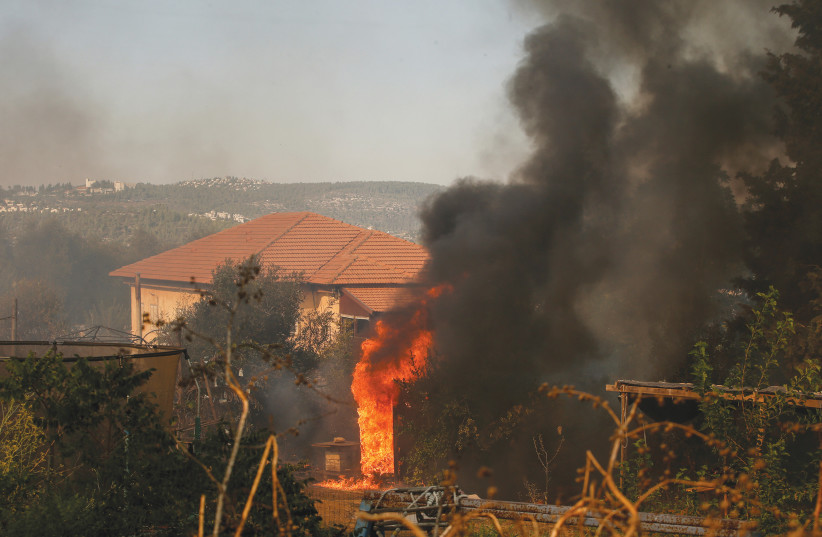In one of the most devastating fires to hit the Jerusalem area in decades, a blaze that flamed for much of the week destroyed nearly 2,500 hectares (6,000 acres) as of Wednesday.
The huge wildfire broke out near the capital on Sunday, burning down hundreds of hectares of forest and brush land and endangering nearby communities. High temperatures and strong winds helped the fire spread fast to the west of the capital.
Huge clouds of black smoke could be seen over Jerusalem on Sunday and Monday, and there was a smokey smell in the air throughout the city. As the large blazes began rapidly spreading towards nearby towns on Monday afternoon, emergency forces began evacuating hundreds of residents from Shoeva, Givat Ye’arim, Kibbutz Tzova, Ein Rafa and Ein Nakuba. About 2,000 residents were temporarily evacuated from their homes.
The fire also affected communities around Jerusalem, including Beit Meir, Ramat Raziel and Shoresh. The Eitanim Medical Center, a psychiatric facility in the Jerusalem hills, near Tzova, evacuated all its patients on Sunday, but they were returned on Monday morning.

Although the fire did place Hadassah-University Medical Center, Ein Kerem, in danger, intensive efforts by about 15 firefighting trucks and firefighting aircraft prevented the flames from reaching the hospital.
Army Radio reported that officials were concerned that they would be unable to safely evacuate the entire hospital.
Firefighters operated at 100 hot spots, according to Fire Chief Insp.-Gen. Dedi Simchi, who stressed that it was a “great achievement” that only a few houses have burned and no one has been killed.
Simchi stressed in a statement to the press on Monday evening that the fire was human-caused, although it was still unclear if it was an accident, due to negligence or intentionally sparked.
Simchi said that the fire is on the scale of the Carmel Forest fire, which burned large swaths of land in the North in 2010, killing 44 people.
The Environmental Protection Ministry warned on Tuesday of high levels of air pollution in nearby areas. The ministry recommended that cardiorespiratory patients, the elderly, children and pregnant women avoid being outside unnecessarily and recommended that everyone reduce physical activity outside, close windows and turn on air conditioners.
By late Tuesday, firefighters had the Jerusalem area wildfire mostly contained, but emergency services expressed concerns that strong winds could cause the fires to spread again later in the week.
Hundreds of firefighters worked around the clock at a number of hot spots to extinguish the fires. On Tuesday morning, eight firefighting aircraft and helicopters began operating to fight the flames, with firefighters aiming to make as much progress as possible while winds were low and humidity was high in order to prevent the spread of the fire.
Ben-Gurion Airport’s special firefighting system joined the efforts on Tuesday, with aviation fire engines that can hold about 12,000 liters of water and have long-range capabilities. The Air Force’s Hercules military transport aircraft also joined the aerial firefighting efforts in an operational experiment on Tuesday.
Earlier in the week, the government requested aid from neighboring countries, including Cyprus and Greece, but by Tuesday, the blazes were under enough control to rescind the request.
However four Palestinian firefighting teams were helping to battle the blaze.
“I would like to thank PA Chairman [Mahmoud] Abbas for his initiative to send the firefighters who came to assist Israel today. Mutual care and saving human lives are common interests to us all,” Defense Minister Benny Gantz said in a statement.
The Communications Ministry announced on Tuesday that the fire had caused damage to a cellular service site, affecting Cellcom and Pelephone service, and Bezeq infrastructure, affecting Internet and telephone service in some locations. A Bezeq broadcast site in Eitanim was repaired after it was damaged.
Environmental Protection Minister Tamar Zandberg warned on Monday that such fires, extreme weather, floods and climate disasters will become more frequent and powerful in the coming years due to the climate crisis. “This requires us to prepare completely differently for the impending climate disasters,” she said. “I am working for the State of Israel to declare a climate emergency. We must define the climate crisis as a strategic threat, which all parties need to prepare for and deal with better. Because from now on, it’s going to get worse and worse. There is something to be done, and it needs to be done now.”
Officials predicted that it may take decades to rehabilitate the area, which had been hit by a number of previous smaller fires in recent years.
Some residents criticized firefighting officials for failing to act quickly enough at the beginning of the fires, which enabled them to spread unfettered.
Ariella Marsden contributed to this report.
